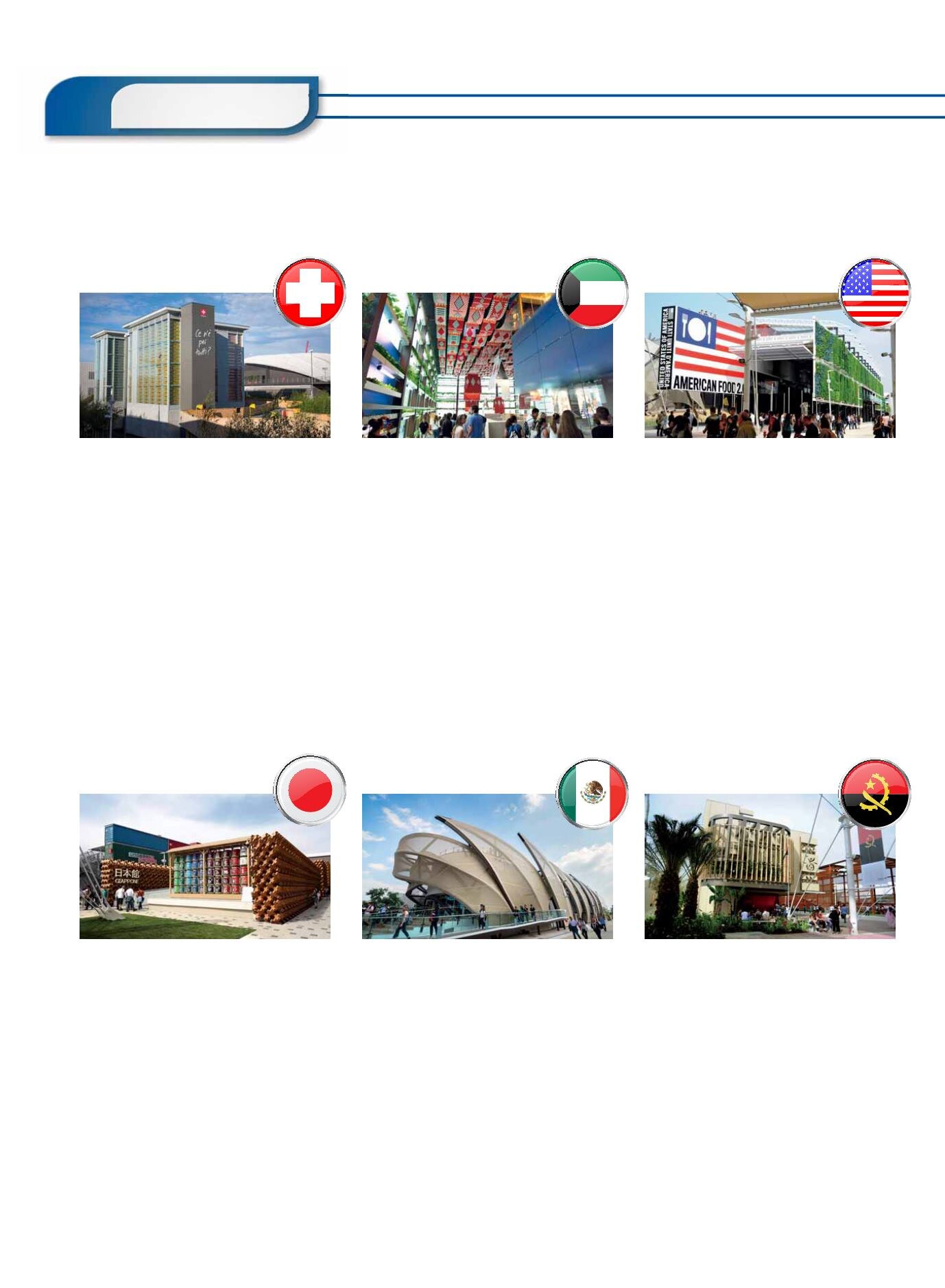
EXPO2015Curiosities
22
EXPO2015: Pavilions in the spotlight
Is there enough to go round?
S
witzerland
was the first country to sign up for
Expo 2015 and one of the first to complete its
pavilion. The structure consists of a largeplatform
with four towers filled with water, salt, coffee and
apples.Visitorscanclimb to the topandhelp themselves,
but there’s just one catch! The quantities of foodstuffs
available have been calculated according to the number
of visitors expected to attend the Expo over its 6month
duration, andwill not be replenished. This means there
may be nothing left for visitors who arrive later on! As
the towers empty, the platform lowers, altering the
shape of the pavilion. The aim of the project is to draw
attention to thedistributionofglobal food resourcesand
tomake visitors reflect on their behaviour as consumers.
The challenge of nature
F
armers in
Kuwait
have to cope with hostile
geographical andenvironmental conditions,with
the country’s notoriously arid climate and dry
soil. Water, agriculture and energy are therefore the
biggest sustainability challenges facing the country.
Theseare the themes explored in its pavilion, which
demonstrates how scientific researchhas succeeded in
creating a hospitable and fertile habitat. The pavilion
structure is based on aDhow, the typical Kuwaiti boat
still used in the Persian Gulf, and the lateral facades
feature examples of the greenhouses and hydroponic
systems widely used in the country.
American Food 2.0
T
he shape of the
United States
pavilion is
inspired by the traditional American barn. The
open structure has several floors which can be
accessed via a wooden walkway repurposed from
Coney Island boardwalk. One of the most distinctive
features is the large “vertical farm” that is harvested
daily. TheUSpavilionexplores the themeof “American
Food 2.0.: United to Feed the Planet”, and showcases
the responsibility and diversity of the American food
industry basedon science, technology, innovation and
free trade.
The harmony of food
T
he structure of the
Japan
pavilion is capable
of withstanding Japan’s frequent earthquakes.
It was built using a combination of traditional
techniques, modern structural analysis and the
compressive stress method - in which individual
elements are connected using coupling systems and
joints. It features a total of 17,000 interlocking pieces
of wood connected in such away as to allow sunlight
to filter through. The inside of the pavilion explores
Japanese food culture and harmonious diversity - a
healthy, sustainable and balanced diet, which is an
example of amodel for alleviating global problems of
hunger and ecology.
The seed for the newworld
T
he construction of the
Mexico
pavilion is inspired
by a large corn cob wrapped in a totomoxtle, the
Nahuatl word for a drymaize leaf. Themaize plant
originated in Mexico and is a staple of the local diet.In
Aztec mythology it gave birth to mankind. The maize
plant therefore represents both the cultural identity of
theMexicanpeopleand the sustainabilityof the country’s
ecosystem. In 2010 Mexican cuisine was declared an
Intangible Cultural Heritage of Humanity by UNESCO
in recognition of its wide variety of plants, animals and
ecosystems. TheMexicoPavilionhasbeenchristened“The
Lanternof Expo2015” since thewallsof the2,000 square
metre pavilion are made from a transparent fabric that
allows light topass throughandcauses it toglowatnight.
Educate to Innovate
T
hearchitectureof the
Angola
Pavilion is inspired
by the “imbondeiro” or African baobab, the
sacred treeofAngolan culture.Angola’s concept
of Educate to Innovate elaborates on the theme of
the Expo by focusing on the culture and soul of the
African nation, through the diversity of its culinary
traditions. Education in schools and universities helps
to promote awareness of nutrition inAngolan society,
and there are rules on local production and imports,
and quality checks in local markets. This journey of
discovery through Angolan cuisine offers an insight
into how the country’s products can be used to
ensure a healthier and more sustainable lifestyle for
future generations.
Credits:
Expo 2015 / DanieleMascolo


